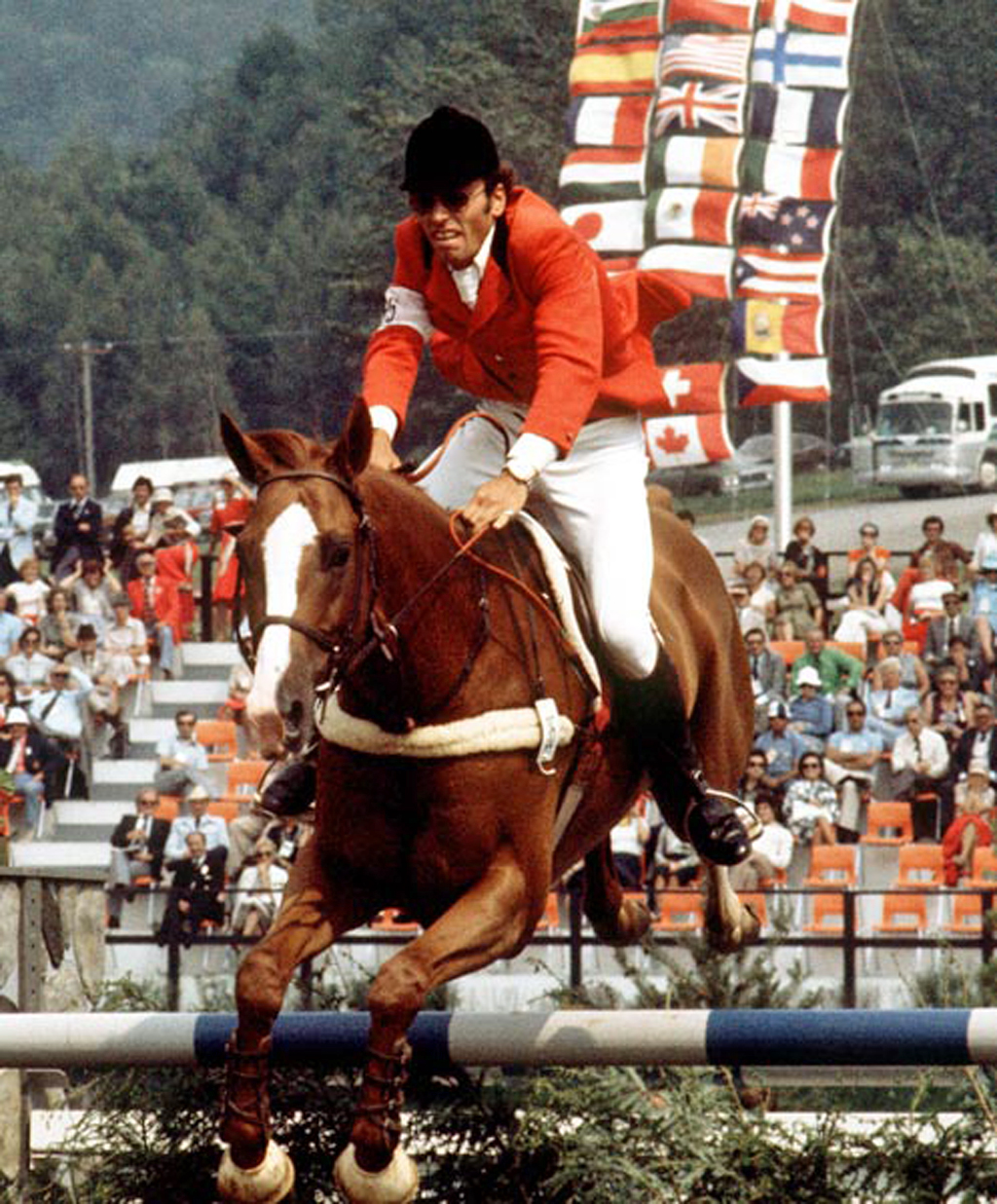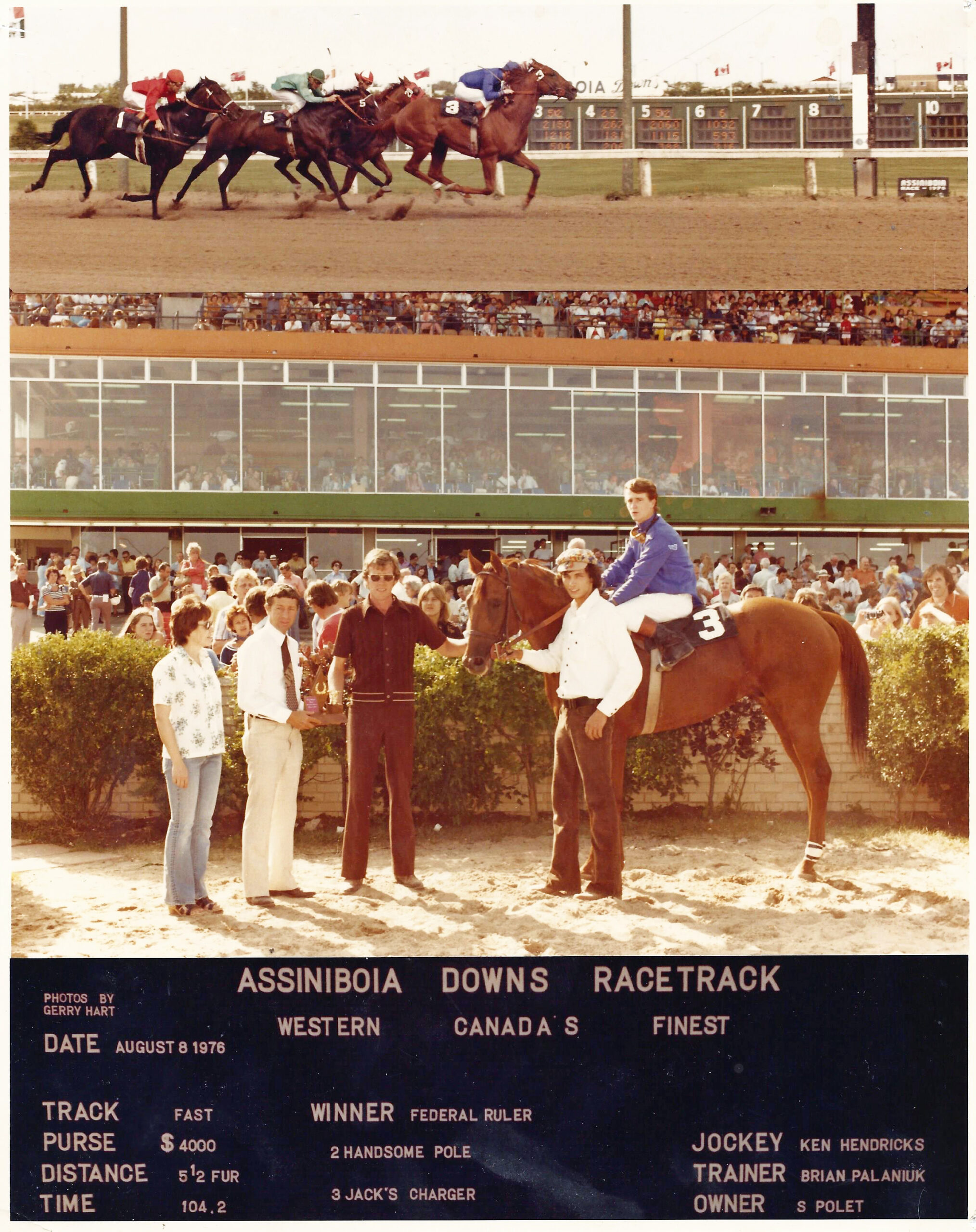
Former racehorse Traffic Sub as Branch County with Michel Vaillancourt aboard winning a Silver Medal at the 1976 Olympics.
by Bob Gates
“A fiery horse with the speed of light, a cloud of dust…”
A catchy start for telling the tale of a thoroughbred, but not so much if it’s the story of Traffic Sub.
Traffic Sub was born and raised on the Minnesota homestead of his breeder George Monroe 50 years ago. As you may have guessed, this chestnut is long gone, but this past April 27 would have been his 50th birthday.
Yet another anniversary, 1969 was quite a year!
In the early years there isn’t a lot to tell you about this boy. Traffic Sub was out of Faid Fleet by Traffic Bridge and was trained by George’s son Milo. Talk about coming from modest beginnings, Faid Fleet was winless in her short racing career and Traffic Bridge was a cripple from birth who never raced.
Monroe liked the breeding of Traffic Bridge however. He was sired by the graded stakes-placed Traffic Judge, who had finished third in the 1955 Preakness Stakes behind the mighty Nashua. So, in the lottery we call horse breeding there was potential. Sadly, it never surfaced in George’s young colt during his racing years.
Traffic Sub made his first start in 1971 and took two more whacks at it in 1972, but never found the charmed circle. Fact is he only beat two horses in each of his three races. On two occasions he was ridden by Downs leading rider Bobby Stewart, so we can rule out the jockey as being part of the problem. After only three races, trainer Milo could tell that Traffic Sub wasn’t going to be any kind of a racehorse.
Traffic Sub’s final racing effort came on May 15,1972. The race was for 3-year-old maidens, each carrying a claiming price of $1,500. Looking back at the field, it’s doubtful the anyone would have even bought all eight of the entrants for $1,500. Talk about a nothing special group. Milo’s patience had been tested and he was satisfied that he had done all he could with the horse. Finding a buyer wasn’t that difficult, as the chestnut gelding’s price tag was cheap enough at $400.

Along came William “Bill” Teske, a former jockey who trained a small stable of thoroughbreds and who later was a racing official at the Downs. Teske’s forte was working with horses in the field of equestrian events and Traffic Sub had something Bill liked. He was big, strong and still had some growing to do, but mostly Traffic Sub looked like he could be a jumper. Give his $400 price tag, there really wasn’t a lot to lose.
In a few short months Traffic Sub’s name disappeared from the sport’s pages and his new alter ego, “Branch County,” appeared on a regular basis for his newfound equestrian career. Teske had renamed the unsuccessful racehorse Branch County after the county in south Michigan where he was born. What a transformation it was, Traffic Sub’s misery turned into Branch County’s quiet confidence. It was as if the chestnut knew the career change was going to be good for him!
What’s in a name? Hard to say, but Branch County got what he needed, a fresh start. A chance to try something new, heavens knows the jumping arena had to be a better place for him than the racing oval.
As early as 1974 local equestrian enthusiasts were put on notice about a local horse that was making his presence felt in jumping arena. Branch County’s successes came early as he captured three of four Rothmans Grand Prix competitions held in the western Canada.
Branch County was a little green, but the 17-hand, one-inch, strapping lad was proving that he was a talented jumper. He was younger than most of his equestrian competitors, but he had raw talent and something that was missing in his life as a racehorse — the desire to excel.
Jumping was a rebirth for the chestnut gelding. With seemingly unlimited potential, his value soared from his $400 rock-bottom purchase price to a figure approaching $100,000. Branch County had grace and stature! He had found his lot in life.

Traffic Sub in his early days, before he became famous.
Teske believed in Branch County and was convinced he could conquer all. An arrangement was reached whereby the horse was given his shot at Olympic glory. In the winter of 1975/76 Quebec’s Michael Vaillancourt and Branch County’s paths crossed with rider and horse becoming a unified team as they made their run towards the 1976 Olympics in Montreal.
Vaillancourt knew he needed to finish in the top two at the Olympic trials in order to earn a spot on Canada’s Olympic Equestrian team. Together the duo finished second and the strong-willed competitors were Montreal bound for the 21st Olympiad.
On Tuesday July 27, 1976 they made a nation proud and delivered a solid silver medal performance. Vaillancourt and Branch County shocked a nation by winning their medal behind 5-time Olympian Alwin Schockemoehle, the first rider in almost 50 years to ride a faultless round in the individual event. Jeers from $2 bettors had been replaced by the cheers of Canadians from sea unto sea.
It was the first individual medal Canada had ever won in an equestrian event at the Olympics. Branch County was the youngest horse ever to represent Canada in the Olympics and the only horse from Manitoba. At 22-years-old, Michel Vaillancourt was the youngest rider ever to represent Canada.
In the wake of Branch County’s Olympic success, Traffic Sub bashing became a national sport. Once newspapers discovered his backstory Traffic Sub was mocked mercilessly. He was a “washed-up racehorse,” an “ignominious failure,” and an “all-time champion loser,” but for the incredibly athletic Branch County it mattered not, for all vestiges of his prior persona had been erased for all time.
One final crowning glory to go with his Olympic medal came in 1978 when Branch County was named Horse of the Year at the Manitoba Horse Council’s annual awards night.
William Paul Teske passed in 1995 after a short battle with cancer, but he believed that everyone had a niche in life, and Branch County had found his.
“Hi-yo Silver, away!”
Acknowledgments:
Thanks to Tony Tweed who has been after me for some time to tell Branch County’s story and to Milo Monroe’s son, Trevor for his assistance with the research on Traffic Sub and Branch County.

